Experience one of the country’s most awe-inspiring natural wonders when you visit Reynisfjara black sand beach in Iceland. With epic views across the thundering Atlantic Ocean, nature is at its most raw and powerful here.
Reynisfjara (pronounced “ray-nis-fi-yah-rah”) is Iceland’s most iconic black sand beach. And for good reason. Head here, and you’ll see mighty sea stacks and sweeping black shores.
Read on to discover why you should add Reynisfjara to your getaway in Iceland.
- Explore the Land of Fire and Ice with these Iceland self-drive tours designed by local experts
Good to know: Sneaker waves are a natural phenomenon that occurs at Reynisfjara. These powerful waves can be dangerous. But with the right safety precautions, you'll still have an incredible time here. Scroll down to find out how to stay safe during your visit.

Where is Reynisfjara beach?
You’ll find Reynisfjara on the south coast of Iceland, just a 10-minute drive from the charming village of Vík. The beach is around 180 kilometres (112 miles), or a 2.5-hour drive, from the capital city of Reykjavík.
To get to Reynisfjara, follow the Ring Road (Route 1) from Reykjavík and take the exit marked route 215. At the end of the road, you’ll come to a car park, public restrooms and a restaurant. The Black Beach Restaurant is an ideal place to stop for coffee, snacks or a light meal.
- Discover glaciers, waterfalls and more with these popular tours of Iceland
- Related: Iceland travel – Everything you need to know

Why should I visit Reynisfjara beach?
There are plenty of volcanic beaches worth seeing around Iceland, but the otherworldly surroundings of this one set it apart.
Here are 5 reasons you’ll want to add Reynisfjara to your Iceland itinerary.
1. There’s local folklore to uncover
With such jaw-dropping scenery, it’s no wonder the area is steeped in folklore. The story you’ll hear most often involves the Reynisdrangar sea stacks standing offshore beneath Mt. Reynisfjall.
According to legend, these enormous basalt towers were once 3 trolls pulling a ship into shore. The unfortunate creatures, also known as “the trolls of Vík”, were turned to stone when they were caught out in the early morning sun.
Step out onto the beach and you’ll see them almost immediately. You’ll also get great views of the Reynisdrangar sea stacks from nearby spots like Vík, Dyrhólaey Lighthouse and the top of Mt. Reynisfjall.
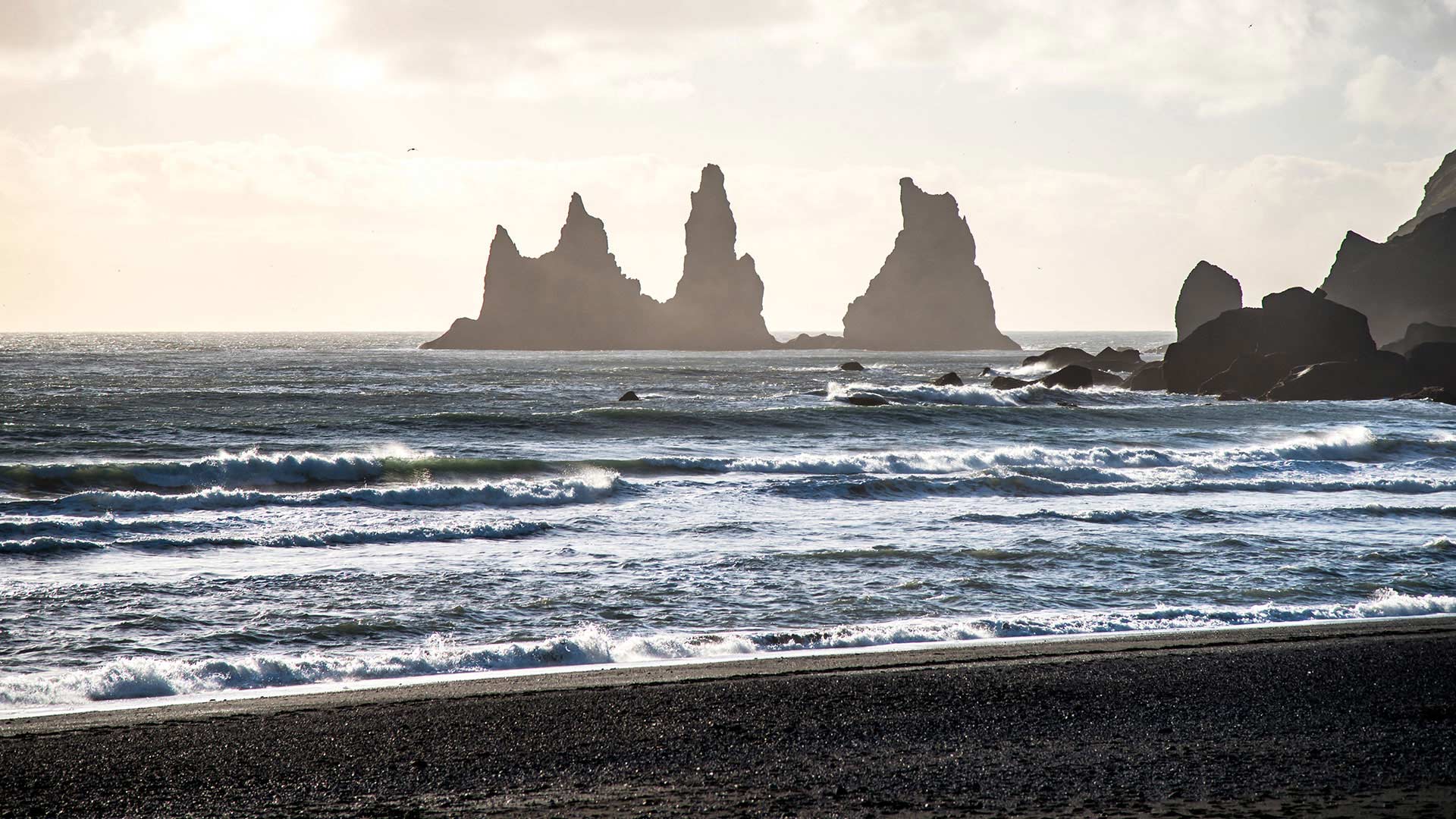
2. It’s a popular filming location
Unsurprisingly, Reynisfjara’s striking black sands and the rugged silhouettes of the Reynisdrangar sea stacks are an irresistible draw for filmmakers.
You might recognise the beach as Eastwatch-by-the-Sea from season 7 of Games of Thrones. Or from the Sci-fi films Rogue One: A Star Wars Story and Star Trek: Into Darkness where it provides a moody backdrop.
3. Puffins nest here in summer
Visit Reynisfjara between late April and August and you could combine two Icelandic favourites – puffins and black sand beaches. Imagine glimpsing these adorable seabirds flying overhead with a beakful of fish as you stroll along the beach.
The country is well-known for its colonies of Atlantic puffins. At Reynisfjara, you can see them flying back and forth between the ocean and their nests on the cliffs and grassy slopes above the beach.
The cliffs near Dyrhólaey Lighthouse are another top spot to see puffins in summer.
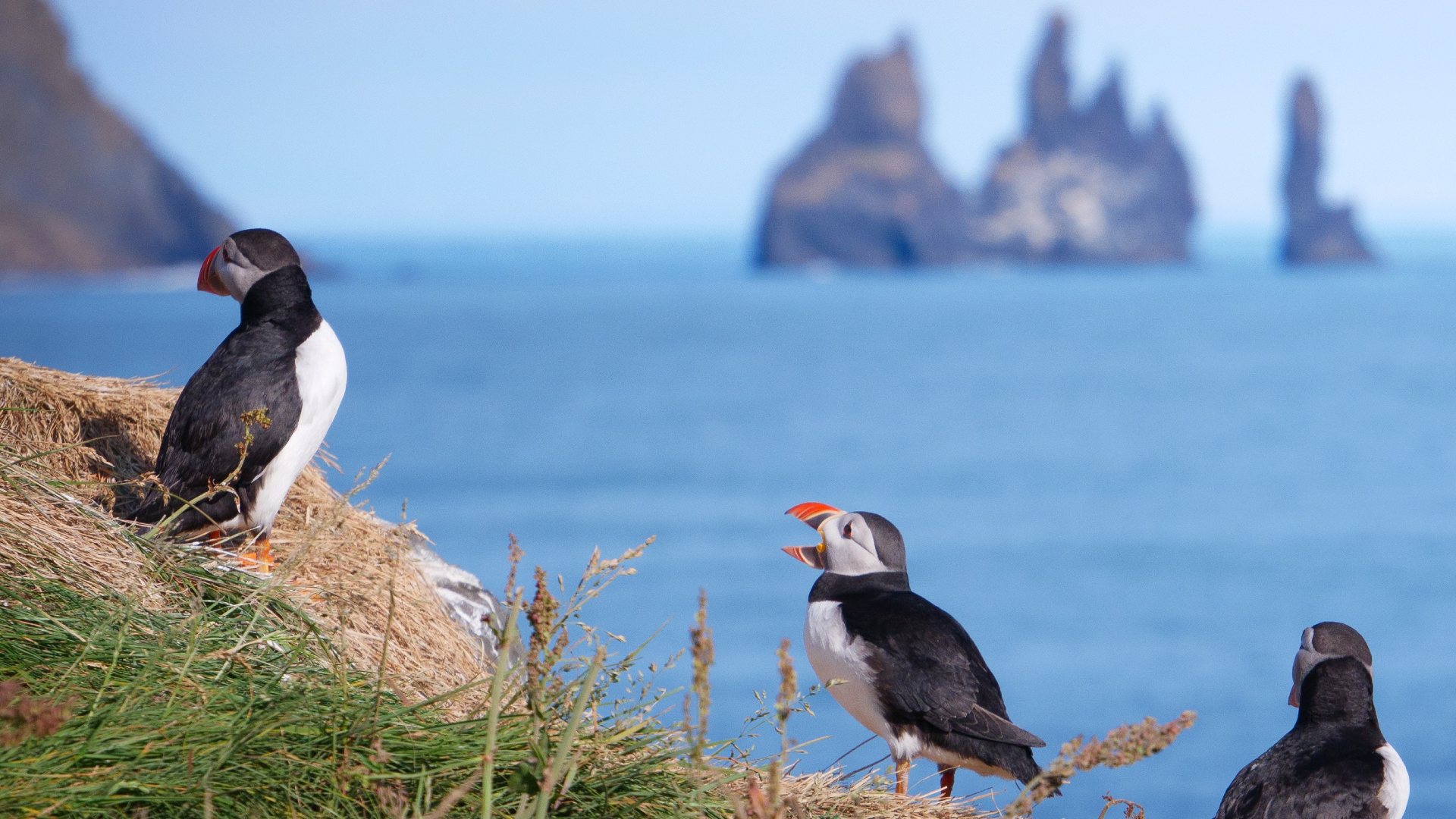
4. Geological wonders await
The black sands aren’t the only draw here. Hálsanefshellir Cave and Gardar Cliff are also well worth seeing. These geological wonders have octagonal, basalt pillars that stretch high into the cliffs overlooking Reynisfjara. Depending on your perspective, they’re shaped like a beehive or a set of organ pipes.
Please bear in mind that the cave and basalt cliffs are only accessible at low tide. Given the unpredictable nature of sneaker waves, it’s important to observe safety measures at all times.
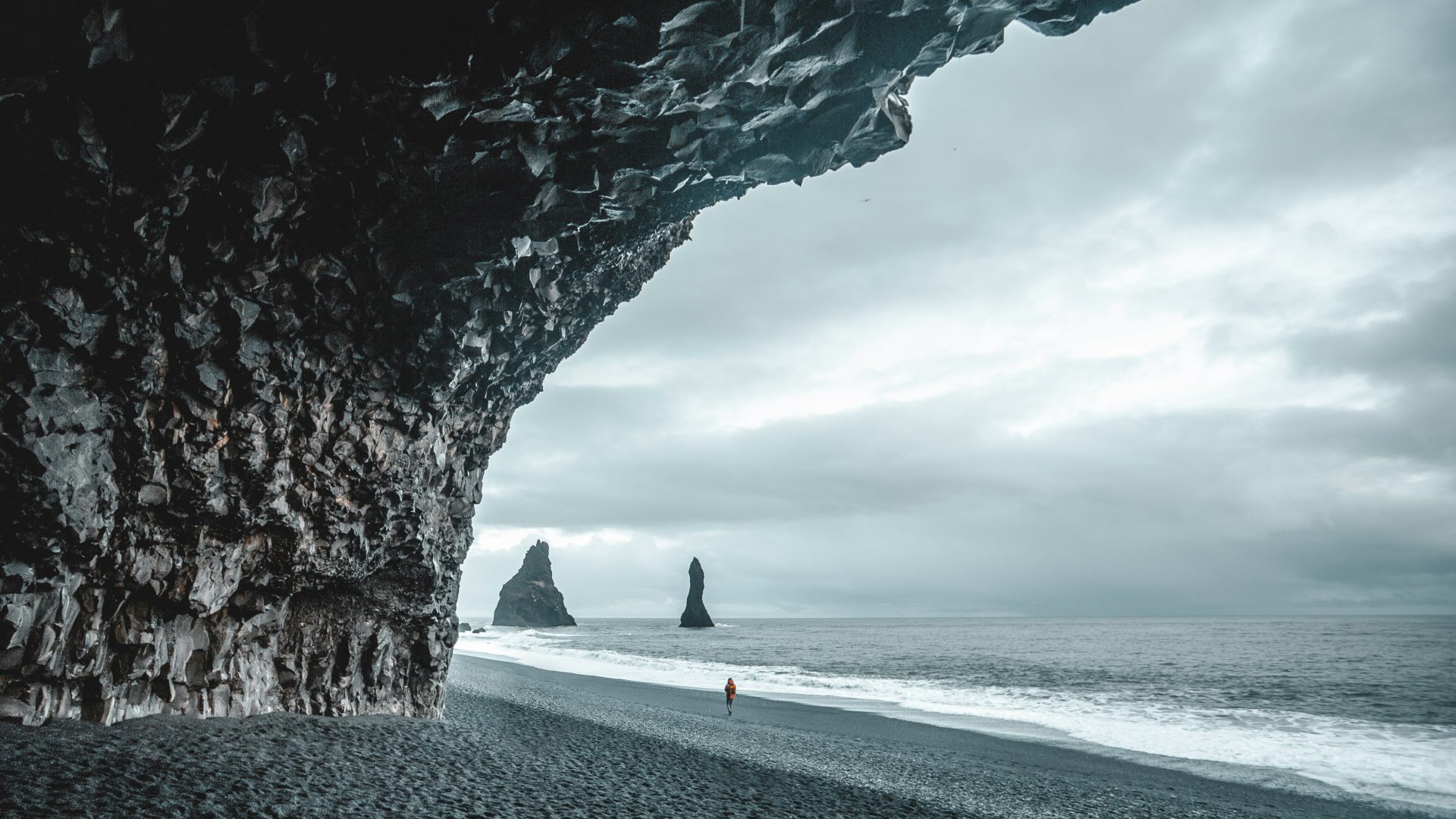
5. Experience the midnight sun or northern lights
Depending on the time of year you go to Reynisfjara, you could explore the beach under the midnight sun or northern lights.
Visit Iceland in summer and you’ll enjoy long daylight hours during May, June, July and August. But if you want the full midnight sun experience, travel in June, when it stays light through the night. Other summertime bonuses include milder temperatures and more wildlife-watching opportunities.
On the other hand, if you want to hunt for the northern lights, take a winter tour of Iceland. You might even glimpse them dancing above Reynisfjara’s bewitching shores!
The aurora isn’t the only reason to travel in winter. From October to April, there tend to be fewer visitors around, and you can see the black sands dusted in snow.
- Chase the magical aurora borealis on these Iceland northern lights tour packages
- Related: Iceland in summer – Things to see and do
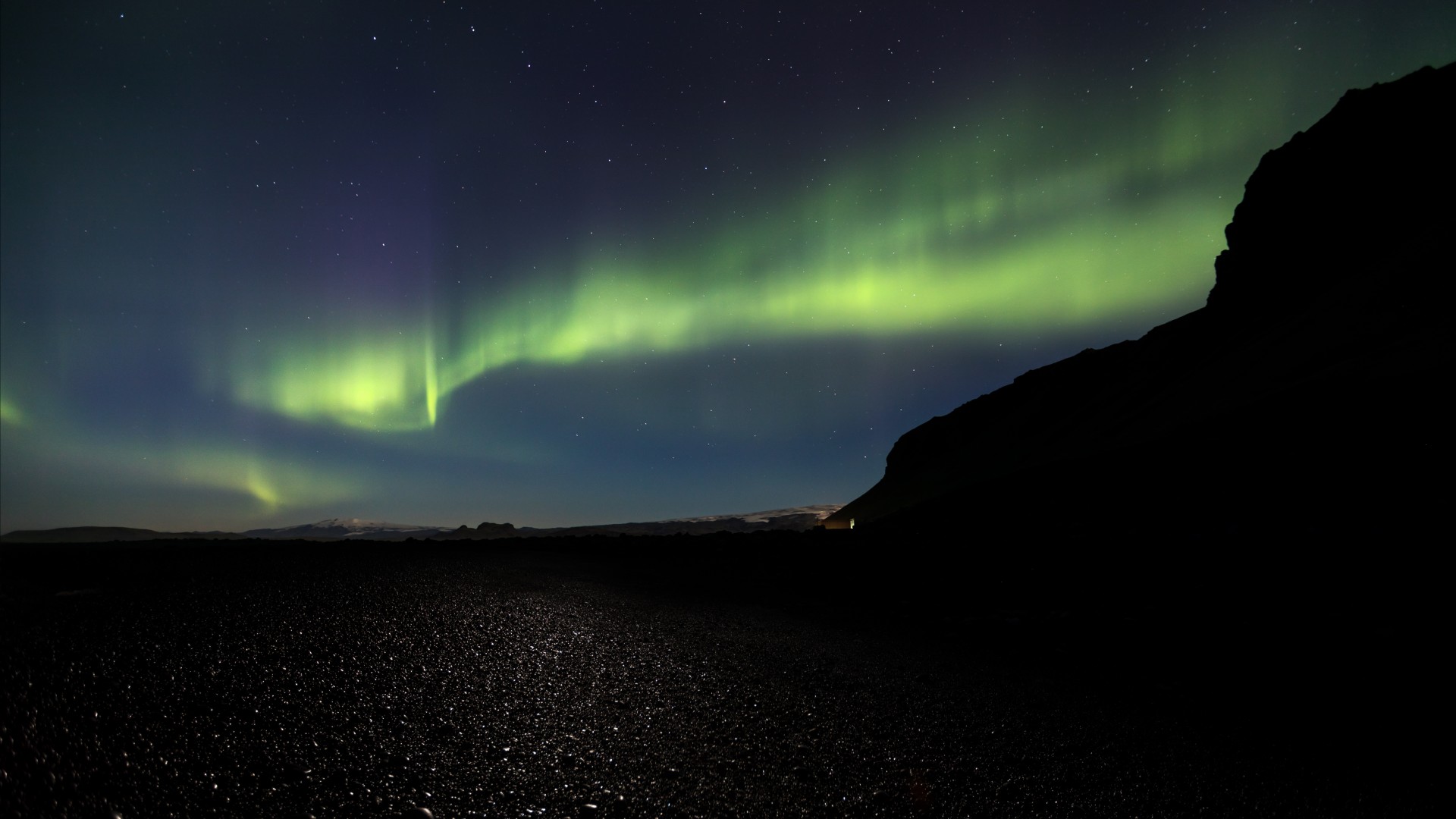
How long should I spend at Reynisfjara?
Around an hour is enough time to soak up the scenery and take photos. But, if you have a few hours to spare, we recommend visiting the nearby village of Vík.
This picturesque spot is only a 10-minute drive from Reynisfjara and offers a range of dining options. Plus, the village has its own black sand beach where you’ll get more amazing views of the Reynisdrangar sea stacks.
Alternatively, turn your trip to Reynisfjara into a full-day tour of South Iceland. On your way to the beach, admire stunning waterfalls like Seljalandsfoss and Skógafoss. From Reynisfjara, you could also head further east to see sparkling icebergs bobbing on the Jökulsárlón glacier lagoon.
- Explore the south coast and beyond from Reykjavík on a multi-day tour of Iceland
- Related: Best Iceland tours to add to your itinerary

How do I stay safe at Reynisfjara?
If you exercise caution, there’s no reason why you shouldn’t add this popular natural attraction to your travel wish list. That said, the sad fact is that people have lost their lives at Reynisfjara black sand beach because they’ve been swept out to sea by sneaker waves.
These waves can appear at any time and are caused by strong Atlantic undercurrents. What makes them so powerful? Well, if you were to draw a line south from Reynisfjara, the next landmass you’d come to is Antarctica. That’s a large distance for ocean waves to gain strength.
When you arrive at the beach, you’ll see warning signs with information on sneaker waves and how to stay safe during your visit. There’s also a traffic light system in place showing you the current risk level.
To stay safe, pay close attention to all warning signs and follow this advice:
- Read the safety signs thoroughly.
- Keep a safe distance from the waves at all times.
- Never turn your back on the ocean.
- Watch any children you’re travelling with closely.
- Don’t visit the caves or the eastern part of the beach during a rising tide, as you could get trapped.
- Keep your distance from the cliffs to avoid any falling rocks.
Stay well back from the water's edge, heed the warning signs, and you’ll have a fantastic time at Reynisfjara.
It’s also worth mentioning that the exposed nature of the beach means the weather can be changeable. So for a comfortable visit, we recommend bringing the right gear. Sturdy footwear, waterproofs and warm clothes – including a jacket, jumper, gloves and hat – are essential.
- Find out more about what to bring on your trip in this handy Iceland packing guide
- Related: Is Iceland safe to visit?

What causes black sand beaches in Iceland?
Iceland is well-known for its volcanic activity. As a result, striking rock formations and inky black beaches define its rugged coastline. But how do they form?
When red-hot lava flows from a volcano or a fissure in the ground, it cools and turns black as it solidifies. Depending on the size of the eruption, these lava fields can cover vast areas.
Over time, the lava fields are eroded by rainwater and rivers. This breaks the rock down into black sand and pebbles, which are deposited at the coast.
Black sand can also come from the erosion of underwater basalt formations that get broken down by the power of the sea.

Are there other black sand beaches in Iceland?
With its haunting beauty, Reynisfjara gets all the attention. But there are lots of other black sand beaches in Iceland.
Diamond Beach is another favourite with visitors to East Iceland. This black volcanic beach is scattered with gleaming icebergs, from the Breiðamerkurjökull glacier.
Alternatively, venture west to the Snæfellsnes peninsula where you’ll find Djúpalónssandur black sand beach.
Located in the stunning Snæfellsjökull National Park, you’ll have views of the park’s glacier-topped volcano on a clear day. For more breathtaking coastal scenery, walk the clifftop path between the villages of Hellnar and Arnarstapi.
- Visit Diamond Beach with a local guide on a small group tour of Iceland
- Related: Things to do on the Snæfellnes peninsula
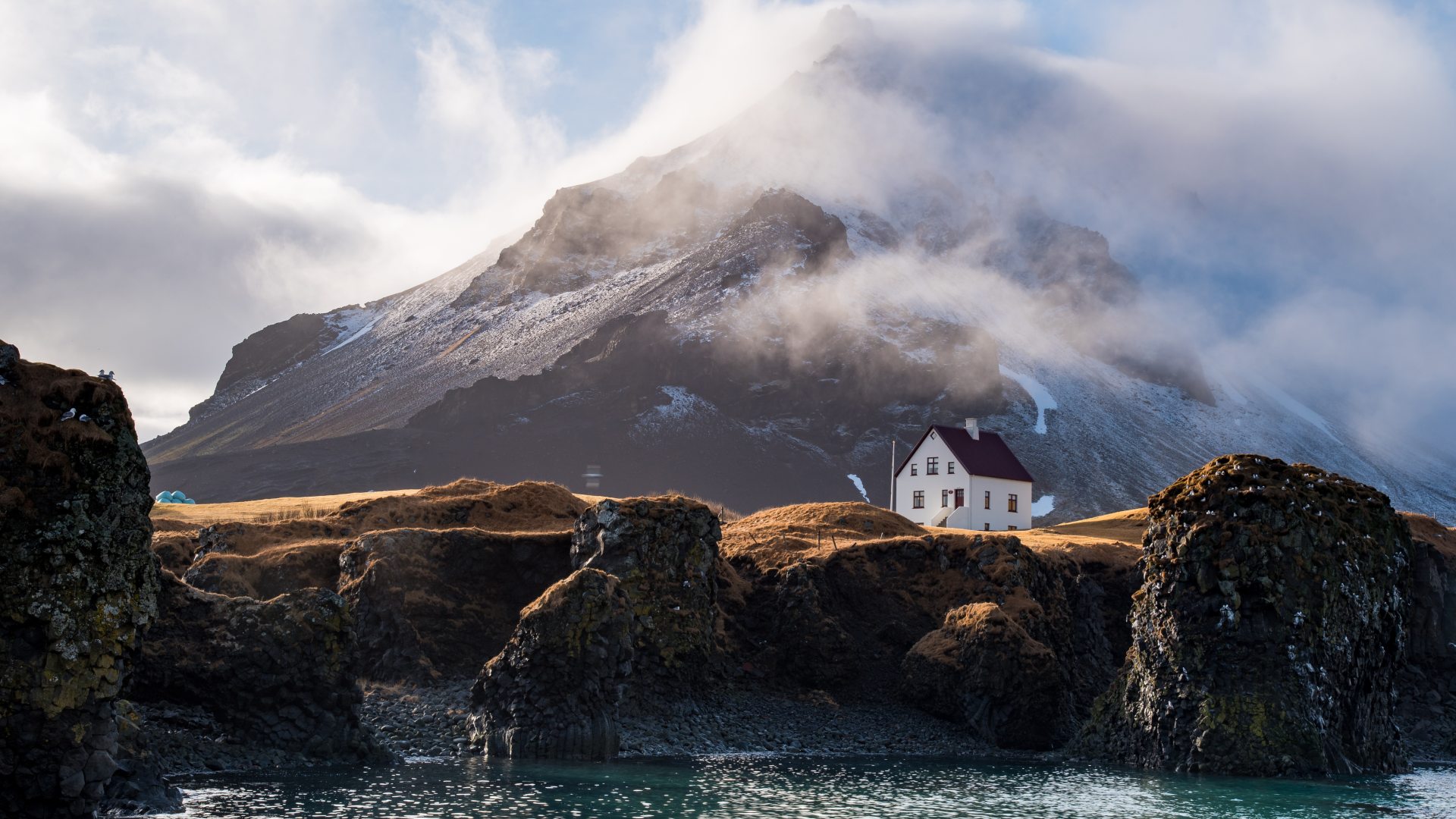
Experience Reynisfjara beach with Nordic Visitor
As Iceland’s most famous beach, Reynisfjara is a recommended stop on many of these self-drive, small group, multi-day and private guided trips. In fact, it’s one of the best places in South Iceland to appreciate the wild beauty of the Land of Fire and Ice.
Book your trip to Iceland with Nordic Visitor and a dedicated travel consultant will arrange your tour package. Your Reykjavík-based travel expert will use their insider knowledge to organise your accommodation, car rental and any optional excursions.
You’ll also get a detailed personal itinerary and a hand-marked route map with attraction suggestions.
Get in touch with us to start planning your adventure into Iceland’s volcanic landscapes.
